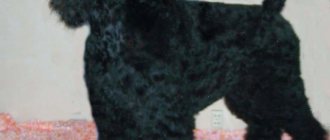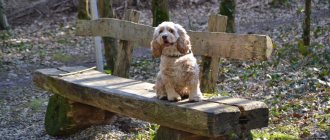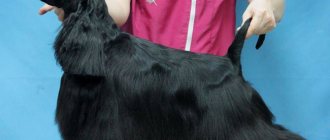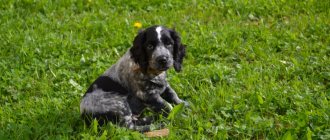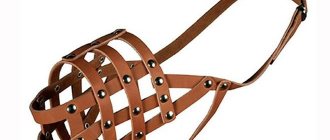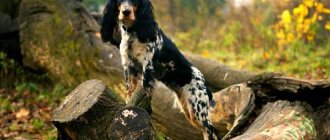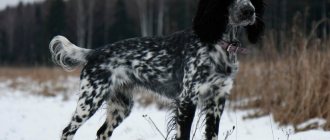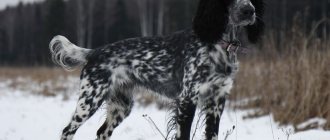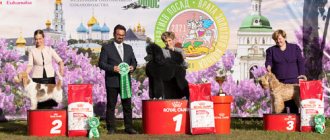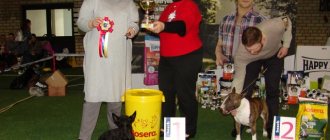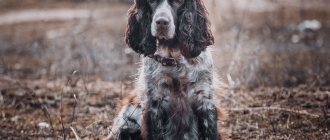Get a dog from titled parents
Buy a puppy you will be proud of! He will win titles at shows and give interesting offspring. Good origin is a guarantee that the pet has the character traits and exterior characteristic of this breed.
The dogs of the canine kennel undergo a mandatory branding procedure, have pedigrees of the Russian Canine Federation and comply with the breed standard. They are healthy, mentally stable, and regularly vaccinated.
Sometimes the chosen puppy needs to wait several months. So that you do not worry about the living conditions and condition of the dog, we regularly send photo and video reports and inform you about its development.
About the section
"Central section of spaniels of the Moscow OOiR"
(TsSS MOOiR, Moscow) - the first section of spaniels that arose immediately after the Great Patriotic War in Moscow. And the section received its name back in 1958, after it became part of the Russian Hunting and Fishing Union created at the same time.
For almost 70 years, the TsSS MOOiR has been fulfilling its main tasks - breeding various breeds of gun spaniels, promoting proper hunting with a dog. Breeds, exhibitions, tests, competitions of various levels, training of young owners made it possible to raise generations of working exterior dogs, excellent hunting helpers and everyone's favorites in the house.
The constant increase in class stock and special interest in the Russian Hunting Spaniel breed allowed over time, based on the number of dogs of the TsSS MOOiR, to organize several more sections in the Moscow region (Podolskaya, Ramenskaya, Orekhovo-Zuevskaya).
Currently, members of the CSS MOOiR are owners of representatives of all four breeds of spaniels registered in the RORS - Russian hunting spaniel, English springer spaniel, English cocker spaniel and Wachtelhund. The vast majority of dogs in the section are Russian hunting spaniels.
The dogs of the section are widely known not only in Russia. Descendants of MOOiR spaniels live and hunt in Belarus, Ukraine, the USA and other countries.
The canine kennel has all the conditions for the harmonious development of your puppy.
After all, a dog’s health and character are established during puppyhood.
The makings of a champion The parents of each puppy have proven themselves at exhibitions of various levels, including major international ones; have the appropriate titles. The babies' ears are set, their stance and movements are adjusted to form exhibition data.
Good heredity and upbringing are necessary conditions for a successful career.
Professional care Pets are walked five times a day in a suburban area. They eat food suitable for their age and breed, and live in spacious heated rooms. Head of the nursery O.V. Ivanova is an experienced breeder, expert in hunting dog breeding, RKF/FCI judge. The kennel's dogs are regularly examined by a veterinarian.
Your puppy will be cared for by professionals.
Help and support You will always receive advice, contacts of veterinarians and handlers, recommendations for care and education. If you leave, leave the dog at the canine kennel for foster care - it will be fed and walked regularly.
Even a lack of knowledge and time will not prevent you from making a true friend!
Call and the owner of the canine kennel will answer all your questions
Composition of the bureau of the CSS MOOiR
Section Chairman
Milovanov Alexander Vladimirovich
Tribal sector
Head of the breeding sector of the Center of Social Sciences of the Ministry of Education and Science
- Milovanova Irina Viktorovna
Members of the breeding sector
- Leus Oleg Anatolyevich
- Yanushkevich Oleg Igorevich
Field sector
Head of the field sector of the Central Scientific Research Center of the Ministry of Education and Science
- Karlin Igor Markovich
Field Sector Members
- Pavel Evgenievich Batenin
- Garmash Alexander Gennadievich
- Lyudmila Vladimirovna Soldatova
Organizational sector
Head of org. sectors
- Olga Vladislavovna Bagrina
Eurospaniel subsector
- Svintitsky Vladimir Yurievich
Information sector
- Nikolai Gennadievich Sysoev
Head of information sectors
- Elmira Yurievna Kalimulina
Breed characteristics
| Short description | |
| Origin: | Russia |
| Conditions of detention: | House with or without garden, apartment |
| Purpose: | Hunting dog, companion dog |
| Color: | Solid solid black, tan or chocolate brown, white markings acceptable |
| Wool length: | Long |
| Adult dog size: | Female height – 36-42 cm, male height – 38-44, weight – 15-20 kg |
| Average life expectancy: | 10-12 years |
| Walk: | Need active walking twice a day |
| Physical activity needs: | High physical activity needs (1.5-2.5 hours of walking or training) |
| Classification of the Russian Cynological Federation (RKF): | Group 8: Retrievers and Gun Dogs, Section 2: Gun Dogs |
| Puppy price: | From 3,000 to 20,000 rubles. Without pedigree – 3000-5000 rubles, pet class – 10000 rubles, breed class – 15000 rubles, show class – 20000 rubles |
Exhibitions, broods
- Moscow Regional Spaniel Brood 03/22/2008
- Moscow regional exhibition of hunting dogs 07/05/2008
- Moscow regional litter of spaniels 03/28/2009
- Moscow regional hunting dog exhibition 06/20/2009
- Moscow Regional Spaniel Brood 03/27/2010
- Moscow regional hunting dog exhibition 06/19/2010
- Moscow Regional Spaniel Breed 03/26/2011
- Moscow regional hunting dog exhibition 06/18/2011
- Moscow Regional Spaniel Breed 03/24/2012
- Moscow regional hunting dog exhibition 06/26/2012
- Moscow regional litter of spaniels 03/30/2013
- Moscow regional hunting dog exhibition 06/23/2013
- Moscow Regional Spaniel Breed 03/29/2014
- Brood of the Central section of spaniels MOOiR 03/26/2016
Features of maintenance and care
The dog gets along well with children and pets. Small rodents can be perceived as prey, so it is better not to leave them alone.
The spaniel can be kept in an enclosure with a warm booth or in an apartment. Experienced hunters believe that when kept in an enclosure, the dog adapts better to weather conditions; there is no harmful effect of home odors on its sense of smell. If a pet grows up in an apartment, you need to walk it a lot (at least 3 hours a day), go to the fields, to nature, to a pond, where it can run around and burn off energy. In any case, for proper upbringing, the dog should not experience a lack of communication with the owner - you need to exercise and play with it a lot.
Proper care is the key to a healthy spaniel. How to care for ROS:
- Combing - after every walk or hunt to check for ticks, remove thorns and grass.
- Wash with shampoo - once every 3 months. Frequent washing dries out the skin, leading to dandruff and itching.
- Weekly examination of the ears and cleansing of wax.
- The main diet is raw meat and boiled offal (working animals are given boiled meat so that they do not spoil the game). The Russian Spaniel is prone to overeating, so the owner needs to control feeding rates.
Competitions
- Moscow regional spaniel duck competition 07/21/22/2007
- Moscow regional spaniel competition for swamp and field game 05/30/06/01/2008
- Moscow regional spaniel duck competition 07/19/20/2008
- Moscow regional spaniel competition for swamp and field game 05/30-31/2009
- Moscow regional competitions of young spaniels for swamp and field game 06/27-28/2009
- Moscow regional spaniel duck competition 07/18/19/2009
- Moscow regional tests of spaniels for marsh and field game 06/22/2010
- Moscow regional spaniel duck competition 07/17/18/2010
- Moscow regional competitions of young spaniels for marsh-meadow and field game 05/28-29/2011
- Moscow regional spaniel duck competition 07/23-24/2011
- Moscow regional spaniel competitions for marsh-meadow and field game 06/29-30/2013
- Moscow regional competitions of young spaniels for marsh-meadow and field game 06/29-30/2013
- Moscow regional spaniel duck competition 07/20-21/2013
- Moscow regional competition of young spaniels for swamp and field game 07/12-13/2014
- Moscow regional spaniel competitions for marsh-meadow and field game 07/10-12/2015
- Moscow regional competitions of young spaniels for marsh-meadow and field game 07/11-12/2015
- Moscow regional spaniel competitions for marsh-meadow and field game 07/15-17/2016
- Moscow regional competitions of young spaniels for marsh-meadow and field game 07/15-17/2016
Russian hunting spaniel training in Moscow and the region.
Russian Hunting Spaniel training classes are held both on-site and at home. The trainer travels to all districts of Moscow: Zao, Szao, Sao, Svao, Vao, Yuvao, Yuao, Yuzao, as well as to cities near Moscow.
Dog training is based on correct relationships, on contact between owner and dog, so dog training should begin as early as possible. The most successful age for education, taking into account imprinting (imprinting), is at 2.5 - 3 months of age .
The center’s staff works individually, selecting the training course that is right for you and your dog, without unnecessary commands or exercises..
How to choose a puppy
Choosing a Russian Spaniel puppy is not difficult. You should try to come to meet your future pet when the litter is not yet sold out. It is advisable that both parents, and not just the mother, be present with the babies.
When you have the entire litter in front of your eyes, it is easier to choose a Russian Spaniel puppy. There is no need to pay attention to a baby who is constantly aloof from others, but you should not take one who is too active either. It’s good if the kitten shows interest in its future owners and comes up to meet them without fear or embarrassment.
Before choosing a pet, you need to decide on the purpose of purchasing it. It is better to choose an exhibition animal from calmer and more flexible kids, paying attention to the bite, the number of baby teeth, the quality of the coat and breed characteristics.
A Russian Spaniel puppy with mobility and a well-built body on high paws is suitable for hunting. And for walks and games with children, in addition to activity, you need to look at the child’s readiness to communicate.
It is worth finding out in advance everything about the ancestors of the litter, asking the breeder in detail about this, asking for documents from the parents for study. The presence of a documentation package indicates the seriousness of the nursery, which will protect against purchasing a puppy with a bunch of hereditary diseases. Also, conscientious breeders will be happy to tell you everything about the breed, its pros and cons.
Among other things, you need to pay attention to the animal’s veterinary passport, which contains notes on vaccinations done in accordance with age.
Distinctive features
This breed is medium-sized, well-built, with a strong body and well-developed muscles. A feature can be considered long hair and variability of colors. At the withers, the animals reach 36-44 cm, and weigh from 15 to 20 kg.
Spaniels are stretched in structure. Their body length is slightly greater than their height. Their limbs are quite long, which makes them adaptable to running through swamps or snowdrifts. The latest standard was published in 2012.
- The head is dry and long. The skull is oval, with a pronounced smooth stop and brow ridges.
- The muzzle is moderately long, narrow (tapering towards the nose), filled in under the eyes. The jaws are strong but soft, with a full set of teeth and scissor bite The lips are thin and pigmented.
- The nose is wide with open nostrils.
- The eyes are medium-sized, oval, not widely set. The color of the iris depends on the coat color: from light brown to dark brown.
- The ears are set at eye level, long, thin, adjacent to the cheekbones;
- The body is streamlined and strong. The back is long and wide. The loin is slightly convex. The croup is sloping. The withers are pronounced. The chest is deep and well descended. The neck is of moderate length, dry, muscular. The belly is tucked in.
- The tail is a continuation of the croup, moderately long, carried at the level of the back or slightly above it. It is docked by half, unless it is prohibited in the country.
- The limbs are dry, straight, parallel, the hind legs are set wider than the front ones. The paws are oval with gathered toes, characterized by the presence of hair between them. Movement : light gallop.
- The coat is straight or wavy, moderately long, close-lying and shiny. Lengthening is noticeable on the ears, limbs, abdomen, chest and neck.
- Colors: solid, bicolor or tricolor in various variations.
Health
The average life expectancy of a Russian Spaniel with proper care is 12-14 years.
The health of the pet and how many years it will live largely depends on the efforts of the owner. The dog needs to be taken to the veterinary clinic a couple of times a year for preventive examinations and tests. This will help to detect this or that health problem in time.
It is also important to know what diseases the Russian Spaniel is predisposed to:
- Obesity - occurs from an incorrectly composed diet, lack of exercise and violation of the regime.
- Allergies are most often food allergies. It is necessary to very carefully introduce new foods into the diet; if you notice an adverse reaction, they are immediately excluded.
- Otitis is an inflammation of the outer, middle and inner ear.
- Blockage of the anal glands - in the chronic form, they resort to surgery and remove the anal glands. In other cases it is treated with medication.
- Mycosis is a disease caused by parasitic fungi that affect the skin and internal organs.
- Piroplasmosis is a febrile blood-parasitic disease.
- Pyometra is an inflammation of the uterus in which purulent discharge accumulates in its cavity.
- Leptospirosis is a bacterial infection that affects the kidneys.
Routine vaccination will help you avoid many diseases. The owner of the dog must treat it with medications against external and internal parasites.
Character
The Russian Spaniel has a cheerful, friendly disposition. From birth, such a dog is distinguished by its desire to bring game to its owner.
During the hunt, he discovers a bird, picks it up and, after a successful shot, brings it to the owner without damaging his teeth. In addition to poultry, this dog is used to hunt wild goats and hare.
The Russian Spaniel always tries to be close to the owner; if this is not possible, he does not take his eyes off him. Whether it's a warm house or a cold swamp, the dog is always near the owner.
Possessing excellent intuition, the spaniel can recognize people with bad intentions. He is unfriendly to such strangers and is suspicious of their actions. If this is a family friend or relative, the dog happily welcomes you and invites you to play.
For children, the Russian Spaniel is the best friend and playmate. He tolerates children's pranks. His energy reserve is so large that he can frolic with the kids for hours on end.
There is no need to leave a hunting dog with small rodents. She might mistake them for prey. He is friendly towards other pets. He can even sleep and eat together with domestic cats.
If one of the household members is in danger, the Russian spaniel turns from a cheerful playful dog into a brave defender. But it is not recommended to make him a guard dog; this can weaken his hunting qualities. Representatives of the breed rarely show aggression.

